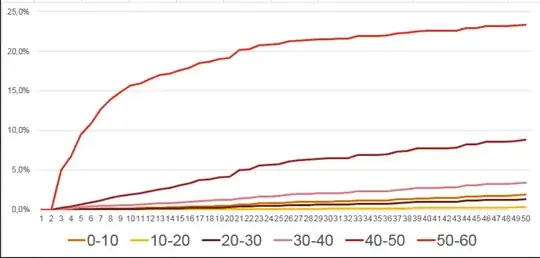Let
- $(E,\mathcal E)$ be a measure space;
- $\rho:E\to[0,\infty)$ be $\mathcal E$-measurable, $p:E^2\to[0,\infty)$ be $\mathcal E^{\otimes2}$-measurable, $$r(x,y):=\left.\begin{cases}\displaystyle\frac{\rho(y)p(y,x)}{\rho(x)p(x,y)}&\text{, if }\rho(x)p(x,y)>0\\1&\text{, otherwise}\end{cases}\right\}\;\;\;\text{for }x,y\in E$$ and $$\overline\rho(x,y):=\left.\begin{cases}\displaystyle\frac{\rho(y)}{p(x,y)}&\text{, if }\rho(x)p(x,y)>0\\0&\text{, otherwise}\end{cases}\right\}\;\;\;\text{for }x,y\in E.$$
Assuming $$\forall y\in E:\left(p(y)>0\Rightarrow\forall x\in G:q(x,y)>0\right),\tag1$$ are we able to show that $$\tilde r(x,y):=\left.\begin{cases}\displaystyle\frac{\overline\rho(x,y)}{\overline\rho(y,x)}&\text{, if }\overline\rho(y,x)>0\\1&\text{, otherwise}\end{cases}\right\}=r(x,y)\tag2$$ for all $x,y\in E$?
This claim is made in this paper on page 8.$^1$ However, it should hold $$\tilde r(x,y)=\left.\begin{cases}\displaystyle\frac{\rho(y)p(y,x)}{\rho(x)p(x,y)}&\text{, if }\rho(x)\rho(y)>0\\1&\text{, otherwise}\end{cases}\right\}\;\;\;\text{for all }x,y\in E\tag3$$ and hence, for example, if $x,y\in E$ with $\rho(x)p(x,y)>0$ and $\rho(y)=0$, then $r(x,y)=0$, but $\tilde r(x,y)=1$.
Am I missing something? If not, can we fix this?
$^1$ They actually claim that $$\left.\begin{cases}\displaystyle\frac{\overline\rho(y,x)}{\overline\rho(x,y)}&\text{, if }\overline\rho(x,y)>0\\1&\text{, otherwise}\end{cases}\right\}=r(x,y)\;\;\;\text{for all }x,y\in E,\tag4$$ but since this is obviously wrong, I suspected that they mean $\tilde r$ instead.
